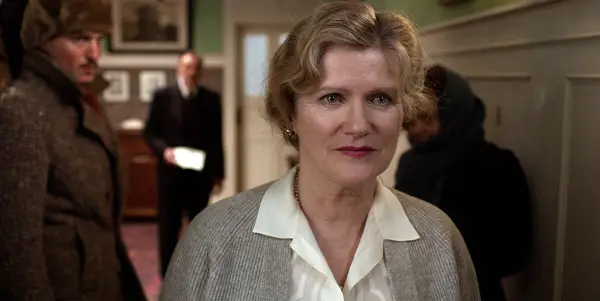STEFAN ZWEIG: FAREWELL TO EUROPE: Beautiful & Smart, But Still Lacking

Lee Jutton has directed short films starring a killer toaster,…
The opening scene of German writer-director-actress Maria Schrader’s Stefan Zweig: Farewell to Europe is an ambitious one. It begins in Brazil in 1936. A long table is flooded with flowers in vibrant pinks, reds and oranges that are being fussily arranged by a team of black-and-white clad maids in a bright white dining room. The shot encapsulates the entire room and remains static – no movement, no change in angle, no cuts – as a door at the far end of the room opens to reveal a crowd standing in thunderous applause.
The crowd enters the room for a dinner to honor Jewish-Austrian exile and renowned author Stefan Zweig (played by Josef Hader in a subtle, sensitive performance), who has stopped off in Brazil on his way to Argentina for a writers’ conference. The scene continues, without cuts, as Zweig and his host sit down at the end of the table, their backs to the camera. The host continues to gush over Zweig, and in return, Zweig gushes over the hospitality he has found in Brazil, a country so far from and so different from his European home.
Visually, the scene is stunning; the contrast between the colorful flowers and the stark black-and-white of the room is a treat to the eye. Yet after awhile, the approximately eight-minutes-long take starts to feel too much like a stunt. The placement of the camera and the lack of cuts start to feel unnatural and annoyingly distracting, while the exchange of pleasantries between Zweig and his host grows repetitive and dull. In the end, despite how beautiful the scene was to look at, I grew impatient for it to end.
On Fascism and Freedom
This opening scene, one of five similar set pieces plus an epilogue that make up Stefan Zweig: Farewell to Europe, perfectly encapsulates everything that is good and bad about the film. The film is impeccably well-crafted and filled with intense intellectual musings about fascism, freedom, and what role the artist should feel obligated to play in a world where the former threatens to destroy the latter. Seventy years after the main events of the film, one cannot help but hear echoes of our modern world’s troubles in every word uttered by Zweig and his compatriots.

Yet every chapter, no matter how well it starts out, slightly overstays its welcome. As a result, the film’s one hour and forty-six minute running time feels almost twice as long. This is disturbingly ironic considering that the film’s epilogue focuses on the immediate aftermath of Zweig and his wife, Lotte (played by Aenne Schwarz) choosing to commit suicide in their home in Petropolis, Brazil; the two of them refused to stay any longer in a world where fascism was tearing apart their beloved homeland. They chose to leave their lives prematurely, while they were still able to make that choice, but before the rest of the world was ready to bade them farewell.
The entirety of Stefan Zweig: Farewell to Europe takes place an ocean away from the troubled continent referenced in the title, as Jews like Zweig and other native sons are forced to emigrate to escape the increasingly powerful Nazi regime. Men of influence, like Zweig, are expected to use their considerable money and resources to barter for safe passage for themselves and the various friends and family that now rely on them to save them from the Nazis. It’s a lot of weight to carry on one’s shoulders when all one wants to do is shut oneself up in a quiet room and write. With each chapter of Stefan Zweig: Farewell to Europe, this weight grows on Zweig and Lotte, leading to their decision to take their own lives at the height of the war, in 1942.
An Author in Exile
When Zweig arrives at that aforementioned writing conference in Buenos Aires, he is persistently pestered by journalists from around the world to offer his own condemnation of the events in Germany, to wield his gift for words as a weapon against the Nazis. But Zweig is reluctant to take such a definitive stance against an entire country and its people, to oversimplify what he feels to be a complex situation worthy of more substantial thought than a few pithy phrases.

Watching another exiled writer rail eloquently and passionately against the Nazis in a speech at the conference, one notices the increased anxiety and awkwardness crossing Zweig’s face. Forced to stand for a round of applause directed at all of the European exiles present, one senses that he resents this kind of attention, the kind that diminishes him from the great writer that he is into a victim, a mere symbol of the great injustice being done across the sea. Throughout the scene, his mouth maintains a tight-lipped smile, but his eyes appear increasingly tired and sad.
New York State of Mind
Following the conference, Zweig travels throughout Brazil and falls madly in love with the country, settling in Petropolis among other European expats and penning a nonfiction book about his newly adopted home. Yet his heart remains torn – half of it trying to find a place to rest in the Brazilian countryside, the other half beating more and more frantically as the land of his birth descends into fascism and war.
Along the way, Zweig takes a brief side trip to New York to visit his first wife, Friderike (legendary German actress Barbara Sukowa, still an imposing presence), for a fraught debate over how much responsibility he has for those left behind in Austria and elsewhere. Friderike believes it is only a small sacrifice on his part to help their friends and colleagues obtain visas and book passage, but Zweig resents that he’s expected to play the part of hero over and over again. Their passionate debate reflects the mutual respect the two have for each other despite their divorce, while also revealing the various differences in opinion and temperament that must have played a role in their marriage’s demise.

The New York chapter falls smack in the middle of the film, and while it is the least visually interesting – taking place almost entirely in a gray Manhattan apartment, lacking the sun-drenched sugarcane fields and splashes of color that characterize the South America scenes – it is also the most intellectually stimulating and the most emotionally powerful. It leads audience members to contemplate and debate what they would do in such a situation, one that in our modern world sadly doesn’t seem too far out of reach. Would they accept responsibility for so many others, or would they try to lose themselves in their work, as Zweig tries so hard to do? These moments are when Stefan Zweig: Farewell to Europe is at its best; they force the audience to think instead of merely lulling them into a stupor.
So Much to Love, Yet Ultimately Underwhelming
In addition to a keen eye for creating beautiful images, Schrader has an eloquent mind for dialogue; the script co-written by her and Jan Schomburg is sensitive and highly intelligent. Her actors, particularly Hader and Sukowa, deliver pitch-perfect performances worthy of these complicated and conflicted characters. Despite these many strengths, Stefan Zweig: Farewell to Europe feels less like a complete film than a loosely linked chain of scenes. On their own, they are lovely tableaux – though, as I previously noted, many drag on for too long – yet they ultimately feel underwhelming pasted together.
The decision to focus on a handful of key moments spread out over six years, as opposed to a straightforward narrative of Zweig’s life, is indeed an intriguing and nontraditional way to approach that increasingly cliched genre of film, the biopic. However, it would definitely be helpful to go into the film with some knowledge of Zweig’s work; I did not, and I am sure that affected my enjoyment of the film, which drops the audience right into Zweig’s life, at the height of his popularity, with little to no explanation as to how he arrived at these great heights. Without previous background of Zweig and his work, one feels almost as adrift watching the film as Zweig does in the Americas.
I suppose it makes sense that film focused on one man’s sense of helplessness and inaction would lack in true action itself. But just because the meandering tone isn’t out of place doesn’t mean it works as far as the enjoyment of the audience is concerned. Stefan Zweig: Farewell To Europe is a fine display of craftsmanship, but feels a bit too infatuated with its own beauty and intelligence to engage on the level to which it aspires.
What do you think? Does telling a story in chapters spread out over years sound like a clever take on the traditional biopic? Share your thoughts in the comments.
Stefan Zweig: Farewell to Europe was released in New York on May 12, 2017 and will expand to Los Angeles on June 16, 2017. For all international release dates, see here.
Does content like this matter to you?
Become a Member and support film journalism. Unlock access to all of Film Inquiry`s great articles. Join a community of like-minded readers who are passionate about cinema - get access to our private members Network, give back to independent filmmakers, and more.
Lee Jutton has directed short films starring a killer toaster, a killer Christmas tree, and a not-killer leopard. Her writing has appeared in publications such as Film School Rejects, Bitch: A Feminist Response to Pop Culture, Bitch Flicks, TV Fanatic, and Just Press Play. When not watching, making, or writing about films, she can usually be found on Twitter obsessing over soccer, BTS, and her cat.













